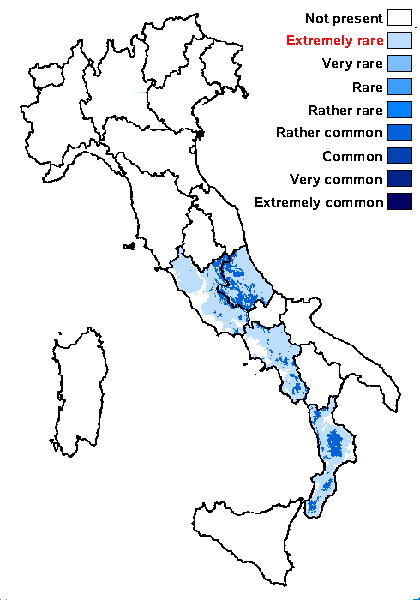Lecanoropsis calabrica (M. Brand & van den Boom) Ivanovich & Printzen
in Ivanovich & al., Phytotaxa, 695, 1: 33, 2025. Basionym: Lecanora calabrica M. Brand & van den Boom - in van den Boom & Brand, Lichenologist, 40: 470, 2008.
Synonyms:
Distribution: C - Laz (van den Boom & Brand 2008), Abr (van den Boom & Brand 2008). S - Camp (van den Boom & Brand 2008), Cal (van den Boom & Brand 2008).
Description: Thallus crustose, continuous to weakly rimose, ecorticate, smooth, whitish, forming up to 1.5 cm patches, often delimited by a bluish grey prothallus. Apothecia lecanorine, 0.4-0.6 mm across, broadly adpressed, with a flat to slightly convex, beige or pale to dark brown disc and a thin, persistent, pale grey thalline margin. Thalline exciple corticate, the cortex 25-55 µm thick at base, colourless, consisting of anticlinally arranged, branched hyphae, often granulose in upper part; proper exciple colourless in inner part, brown in the outer rim, up to 35 µm wide; epithecium colourless to very pale brown, the pigmented parts N+ violet-red; hymenium colourless, 45-70 µm high; paraphyses simple, coherent, up to 2.7 µm thick; hypothecium colourless, up to 120 µm high. Asci 8-spored, clavate, very thin-walled, with a K/I+ blue, tall tholus penetrated by a faintly amyloid apical cushion, the wall K/I-, surrounded by a blue outer layer, Lecanora-type. Ascospores 1-celled, hyaline, broadly ellipsoid to subglobose, 8.4-9.6 x 5-5.7 µm. Pycnidia immersed, colourless or pale brown near the ostiole. Leptoconidia thread-like, curved, 22-27 x 0.6-0.9 µm. Photobiont chlorococcoid. Spot tests: thallus K-, C-, KC-, P-, UV-. Chemistry: thallus with isousnic acid. Note: a recently-described species growing on the smooth bark of Abies and broad-leaved deciduous trees in mountain areas, apparently not uncommon in the southern part of the Italian Peninsula and also known from Croatia. It is superficially very similar to Polyozosia hagenii, differing in the chemistry and in the wider, subglobose spores. Several samples of P. hagenii reported from upland areas of Central and Southern Italy should be checked against this species. For further details see van den Boom & Brand (2008) and Ivanovich & al. (2025).
Growth form: Crustose
Substrata: bark and lignum
Photobiont: green algae other than Trentepohlia
Reproductive strategy: mainly sexual
Pioneer species
Commonnes-rarity: (info)
Alpine belt: absent
Subalpine belt: absent
Oromediterranean belt: absent
Montane belt: rather common
Submediterranean belt: extremely rare
Padanian area: absent
Humid submediterranean belt: extremely rare
Humid mediterranean belt: absent
Dry mediterranean belt: absent

Predictive model
Growth form: Crustose
Substrata: bark and lignum
Photobiont: green algae other than Trentepohlia
Reproductive strategy: mainly sexual
Pioneer species
Commonnes-rarity: (info)
Alpine belt: absent
Subalpine belt: absent
Oromediterranean belt: absent
Montane belt: rather common
Submediterranean belt: extremely rare
Padanian area: absent
Humid submediterranean belt: extremely rare
Humid mediterranean belt: absent
Dry mediterranean belt: absent

Predictive model

